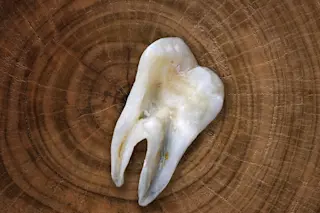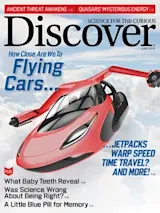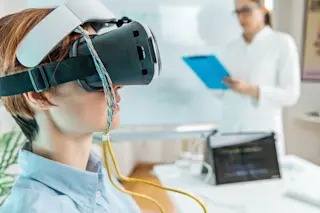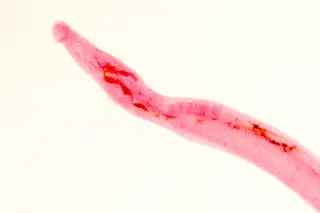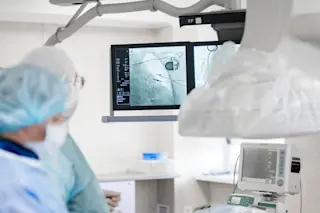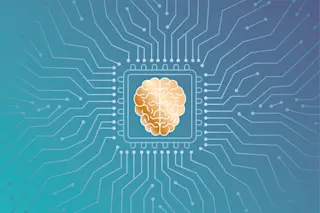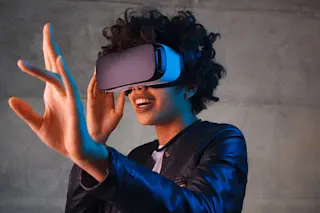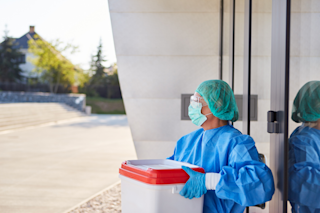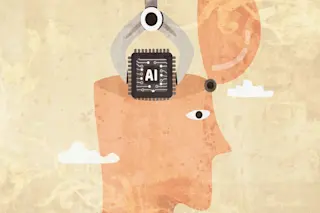Manish Arora studies a young boy’s tooth on his computer screen, searching for crucial details about the child’s past. The boy, 10 — we’ll call him Max — lives outside a poor community in Mexico City where lead exposure is a chronic problem. And it shows in the tooth. Max has been around lead from polluted air and water — and even food, because the metal leaches from lead-glazed pottery.
The image on the screen is essentially a color-coded map of the boy’s tooth. It shows Max had a spike in lead exposure just before birth, in the final months of fetal development. After birth, his exposure dropped off to a level common in the local population.
Blood tests can detect lead at any given moment, but they don’t reveal past exposures or time-stamp when they happened. Teeth, Arora has discovered, can do both — not just for lead, but for a growing number of other elements and chemicals, too. That finding holds tremendous potential for environmental health research, like trying to unravel causes of autism spectrum disorder. And it’s why scientists around the world, from Mexico to Sweden to Iraq, have been flocking to Arora, a dentist and exposure biology director at Mount Sinai’s Frank Lautenberg Environmental Health Sciences Laboratory.
He’s turning teeth into time machines.
“Imagine if you measured blood lead level here,” Arora says, pointing to a part of the tooth that had grown after birth. “You’d think there’s less risk. But travel back in time. Just before birth, there’s a huge spike in lead exposure.”
Steps from Arora’s surprisingly modest upper Manhattan office, where his desk is dotted with pictures of his young triplet daughters, his sprawling lab is filled with unassuming-looking equipment. But in a matter of hours to a little more than a day, Arora can determine what a tooth — often one dug up from years of sentimental storage — was exposed to over the course of its lifetime. For baby teeth, that often extends back to the end of the first trimester. This time machine has not only turned Arora into something of a celebrity in environmental health, it is also revolutionizing a field that has long focused on the dose of a substance a person is exposed to when evaluating its toxic effects.
Teeth form rings as they grow — just like trees, but every day rather than every year. They also form a distinct ring on the day of birth, the neonatal line. Arora uses these rings to measure, with surprising specificity, when the body was exposed to certain substances. In the process, he’s shown that timing can be critical in determining the type and severity of harm from a chemical exposure.
You Know the Drill
A soft-spoken man, Arora had a dental practice in India, but gave it up to pursue ways of integrating the environment into his work. He didn’t discover that teeth store records of past exposures; he had studied the work of environmental scientists who’d used ground-up teeth to measure the total amount of a metal in the tooth. He also wasn’t the first to use a laser to reveal chemical fingerprints — geologists had long used them on rocks. But Arora says nature inspired him to combine the techniques. He knew that tree rings record environmental conditions in specific years, and he thought surely the growth rings in teeth could be used for a similar purpose.
At the time, however, in the early 2000s, he was a struggling graduate student in Australia. When he sought funding to test his unconventional concepts, grants didn’t exactly roll in. He was also taking an unconventional approach to research, mixing disciplines and talking with nuclear physicists, geologists, biostatisticians and others rather than looking to mentors in his own field. “I kept reaching outside my training, which was scary,” he says.
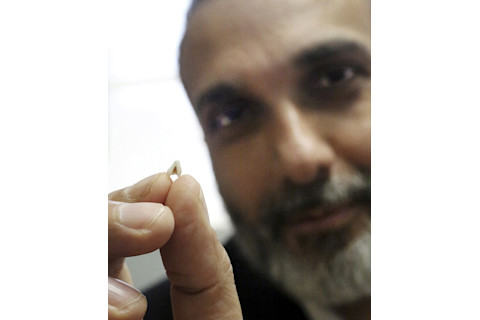
A tiny baby tooth like this one, held by Manish Arora, can reveal an enormous amount of information about environmental toxins. Yana Paskova
Confident he was onto something, he persisted, finding small grants and eventually a sympathetic geologist who let him use his earth and planetary sciences lab when it was empty. He didn’t have his own key, though, and there were no restrooms inside the lab. With no way to re-enter, he learned quickly to moderate his water intake before his long nights would begin. Eventually he got used to trapping himself in the lab at night, alone, for months on end, trying to see if teeth served as biomarkers of lead exposure.
Now, he runs his own lab and employs researchers whose expertise ranges from histology — the detailed study of biological cells and tissue — to hummingbird songs.
It’s an unusual mix. In a research group focused on teeth, he’s the only dentist. “I’m not really interested in treating tooth decay,” Arora says. “I’m interested in people who can look at any human tissue and see what information it is carrying.”
Chasing Lead
The whole process starts in a small room where a saw sits at the edge of a long counter.
Here, Arora or one of his lab researchers divides a tooth in two using a special blade, then polishes the resulting surface with a paste containing fine diamond particles until it’s smooth. Then he feeds it into a laser that creates tiny craters and detects metals. Or, if he’s searching for organic chemicals in the tooth, he hands it off to a robot that can suss them out using a mass spectrometer that produces a series of numbers, like points on a map. These instruments tell Arora what compounds are in the tooth and where they’re located. Each data point, he explains, adds a pixel to his overall map of the tooth.

Researchers use a precision saw to slice a tooth in half before studying it in Arora’s lab at the Icahn School of Medicine at Mount Sinai in New York. Yana Paskova
Arora is chasing exposures to a range of chemicals. But often, he’s looking for lead exposure. Lead is found all around us, and it can harm a significant number of vital systems and organs. That’s because lead competes with essential minerals like calcium and zinc in the body. It’s especially dangerous for kids because their growing bodies absorb more lead and their nervous systems are more sensitive. Scientists are also learning that lead is stored alongside calcium in our bones, accumulating over time.
Using Arora’s lab, Henry Ford Health System epidemiologist Andrea Cassidy-Bushrow and her team discovered that some children in Michigan were exposed to lead before they were born, and the lead exposure declined after birth. The babies likely absorbed lead that their mothers were exposed to years, perhaps decades, earlier.
“I’m sitting here kind of dumbfounded,” says Barbara Williams, a Detroit mother who took part in the study. “When you’re pregnant, you think about everything you are intaking. . . . You don’t think about how something you did maybe six months ago might affect your pregnancy.”
Researchers believe that instead of absorbing calcium, the babies were absorbing lead — which the body can mistake for calcium — from their mothers’ bones during the latter half of pregnancy. That’s the time when a rapidly growing fetus needs huge amounts of the bone-building mineral.
And there was a clear exposure pattern. “We’re seeing very consistent disparities along racial and ethnic lines in lead exposure,” Cassidy-Bushrow says. “African-American children are at much higher risk of lead exposure than Caucasian children, and this persists even when we take into account where they live, the age of their housing and their household income — anything you think might be a cause.”
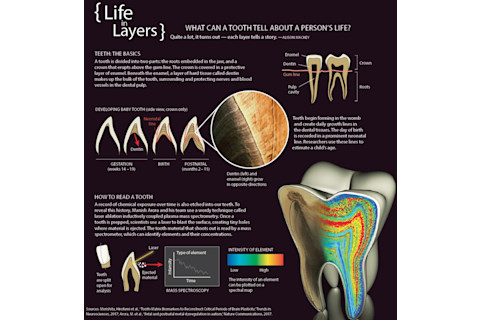
Alison Mackey/Discover; Large Tooth illustration courtesy of Ian Harrowell, Christine Austin and Manish Arora; dentin inset by Biophoto Associates/Science Source
For Arora, this disparity is an environmental justice issue. Women, even those who do everything they can during pregnancy to give birth to healthy babies, essentially pass down their prior lead exposure. That happens with any woman regardless of race. But because African-American women tend to have had greater exposure to lead in their lifetimes than white women, their children more often enter the world with an automatic disadvantage. While there are many ways to prevent lead exposure in the first place, these women and children can’t do anything to prevent or fix it in their circumstances.
“African-American kids have more lead, we know that,” Arora says.
“It just seems like something that should be unacceptable in a First World country like ours,” he adds. “Why are you inheriting such an injustice even before you were born?”
85,000 Chemicals
Arora first used his tooth time machine to detect lead. Now, he and his colleagues are trying to expand their Detroit study to lead-stricken Flint, Michigan, and beyond, looking for additional impacts from the widespread recent lead exposure. He’s also shown that teeth record weight changes and stress. And he’s now examining a range of other substances that the technology can detect in teeth, including other mineral elements, and chemicals like pesticides and phthalates — a potentially harmful compound in many consumer goods.
His team studied the children of California farmworkers, for example, and found elevated levels of manganese, which is used in fungicides. It’s an essential nutrient for plants and animals, but at high levels, it can harm the central nervous system, including brain function. Arora’s team tied those high manganese levels — seen before and just after birth — with negative behavioral patterns in kids aged 7 to 10. They even showed manganese levels were higher when farmworkers brought their work shoes or clothes inside.
Ultimately, his vision is to revolutionize how we understand environmental health. First, he wants scientists to appreciate the timing of exposures, as opposed to just the dose. He’s also trying to help shift the field away from studying chemicals one by one, and toward studying how mixtures of substances — which is how people are exposed to things in real life — affect human health.
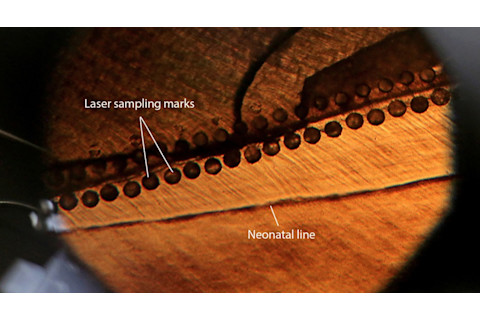
Tooth samples get zapped by lasers, creating tiny craters along the tooth. Yana Paskova
In doing so, Arora is advancing an emerging field called the exposome; he wants to study a lifetime of exposures and the resulting health impacts. The field has gained momentum among environmental health researchers and with government funding from agencies like the National Institutes of Health (NIH).
But it also faces intense skepticism. Exposome research could be compared to casting a vast fishing net, whereas the conventional scientific method is more like using individual fishing rods. The single rod — a focused hypothesis to test in a traditional experiment — is great if you know what you’re looking for and where it is. But researchers have realized the wider net is useful when you recognize how much you don’t know, and you want to account for all possibilities that may exist.
“It’s a completely different way of doing research than everybody in the field was trained to do,” says Robert Wright, director of Mount Sinai’s Institute for Exposomic Research.
Wright is an exposome proponent, and he helped bring Arora to Mount Sinai and helped find resources for his lab. And he says the exposome is gaining traction, but it was once controversial enough that just mentioning it in a proposal might kill funding.
This wider-net approach could be crucial if researchers are going to catch up to the realities of modern environmental health risks. Studying one chemical at a time — like lead or bisphenol A, a common additive in plastics — will never make a dent in understanding the impacts of the 85,000-plus chemicals on the market today. And from the beginning, Arora has made a point of defying traditional approaches.
In the past, scientists have used personal history questionnaires to assess exposure to lead and other toxins. But such surveys are imperfect; people rarely self-report accurately because they’re unaware of their exposures. “That’s the real breakthrough that Manish’s work has generated,” Wright says. “We can measure exposures objectively going back in time.”
Wright is now expanding this approach to do population-level studies. He’s measuring air pollution levels back to 2005 to better understand how the pollutants affect people’s health. It’s a far cry from looking at individual teeth, but it builds on Arora’s work.
Connecting Ailments to Exposures
Arora sees this tooth technique as an equal-opportunity assistant for studying diseases of all kinds, and it may be starting to fill in knowledge gaps on causes of conditions that have long eluded scientists.
Sven Bölte and Kristiina Tammimies, researchers at Sweden’s Karolinska Institute, have been studying environmental connections to autism spectrum disorder for years. Bölte says they’ve controlled for genetic causes as much as they can. Now he hopes Arora’s techniques will let them identify environmental factors. Discordant twins — twins who don’t share the same physical disorders or traits, such as one with asthma or autism and one without — provide opportunities to look at environmental factors while also eliminating genetic variables. A tooth offers a time capsule of what a child was exposed to before autism appeared. “Everything else, we collect when the symptoms are already there, or children are already diagnosed,” he says. Hair could have been one other possibility, he continued, but it doesn’t go as far back as teeth, and some children aren’t born with hair.
When Arora examined the teeth collected by Swedish researchers, he uncovered a surprising pattern. Children with autism had lower levels of zinc and manganese in the third trimester of pregnancy — and lower levels of manganese after birth — than their twin siblings. “From the first study, I was really amazed about the timing,” says Tammimies. “That is one of the key impacts. We can use [Arora’s] tools to start pinpointing the exact timing of the exposure.”
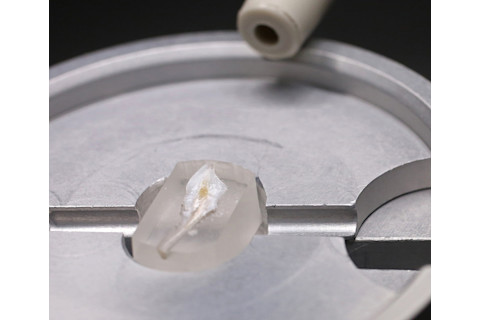
The particles blasted from the tooth are then analyzed for trace metals and other potential toxins. Yana Paskova
Starting in 2015, Arora led an NIH study that reached similar results. Again looking at twins, his team found that baby teeth from kids with autism had higher levels of lead and lower levels of manganese and zinc. Their findings suggest that exposure to metals — and how the body processes them — could be important to the risk of autism. Arora and his colleagues have since replicated these early results in a larger study presented to the NIH in February.
Right now, Arora has collaborations with researchers all around the world — looking at autism in Sweden and Mongolia, neurodevelopmental disorders in Mexico City, impacts of arsenic in Bangladesh, plus lead in Michigan, among others. In New York City, he’s collecting teeth shed by children born around 9/11, analyzing what they were exposed to and how those exposures may be influencing their health. He’s also looking at health problems in adults, such as Parkinson’s disease and Lou Gehrig’s disease.
Arora has intentionally avoided a more conventional focus on one particular disease. His goal is to understand many diseases and the impacts of many exposures — and to move the entire field of environmental health toward studying a bigger picture, rather than one disease or chemical at a time.
“If the environment is important to our whole physiology, then by that definition it’s also important to many perturbations of that physiology, so it’s important to many diseases,” he says.
With excitement for the future, Arora says he aims to analyze teeth for tens of thousands of chemicals at a time. He has proposed working with the Undiagnosed Diseases Network to study rare, poorly understood diseases, and he is trying constantly to figure out new ways to understand the environment’s influence on human health.
Sitting in his office, between phone calls with distant collaborators and consulting with his lab staff, he looks at the boy’s tooth from Mexico City. The lead analysis was part of an ongoing study he’s conducted with partners including the National Institute of Public Health of Mexico, which wants to reduce lead exposure.
“Their mission is to bring about positive changes for public health,” he says.
Ultimately, that’s what he wants the tooth-as-time-machine technology to be used for. The more we learn about which things in the environment are harming our health and when, the more we can avoid them when it matters most.


